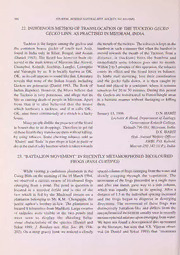
Indigenous method of translocation of the tucktoo Gecko gecko Linn. as practised in Mizoram, India PDF
Preview Indigenous method of translocation of the tucktoo Gecko gecko Linn. as practised in Mizoram, India
) 302 JOURNAL BOMBAYNATURALHIST. SOCIETY Vol. 93(1996) INDIGENOUS METHOD OF TRANSLOCATION OF THE TUCKTOO GECKO 22. GECKO LINN. AS PRACTISED IN MIZORAM, INDIA Tucktoo is the largest among the geckos and the mouth ofthe tucktoo. The tobacco is kept on the the common house gecko of south east Asia, bamboo in such a manner that when the bamboo is found in India only in Bihar, Bengal, and Assam moved towards the mouth of the Tucktoo, from a (Daniel 1983). The lizard has however been ob- distance, it (tucktoo) bites the bamboo and served in the main towns of Mizoram like Aizwal, immediately some tobacco goes into its mouth. Champhai, Kolasib, Serchhip, Lunglei, Lawngtlai Within 2 to 5 minutes of this operation, the tobacco and Vairangte by us. It is locally known as OK. exerts its effect and the lizard loses its balance. OK., as its call appears to sound like that. Literature Its limbs start shivering, lose their coordination reveals that none of the Indian lizards including and the gecko falls down, it is then caught by Geckos are poisonous (Daniel 1983, The Book of hand and placed in a container, where it remains Indian Reptiles). However, the Mizos believe that senseless for 20 to 30 minutes. During this period the Tucktoo is very poisonous, and allege that its the Geckos are translocated to Forest/Jungle areas bite as causing death of people in Mizoram. Apart in a humane manner without damaging or killing from that it is also believed that the house them. which harbours a tucktoo, and if it calls OK.. HARIT OK., nine times continuously at a stretch is a lucky January 13, 1996 D.N. house. Lecturer & Head Department ofZoology, , Many people dislike the presence ofthe lizard Government Kolasib College, in houses due to its droppings. Therefore to get rid Kolasib-796 081 Mizoram, India. , ofthese lizards they translocate them without killing, D.K. HARIT by using tobacco. Some chewing tobacco sold as Hon. Animal Welfare Officer, ‘Khaim’ and ‘Sada’ in pan shops is kept as paste or AWBI, P.O. Kaland , dry at the end ofa dry bamboo which is taken towards Meerut-250 342 ( U.P.), India. 23. “BATTALION MOVEMENT” IN RECENTLY METAMORPHOSED BICOLOURED FROGS RANA CURTIPES ( While visiting a cardamom plantation in the spaced column offrogs emerging from the water and Coorg Hills on the morning of the 19 March 1994, slowly creeping through the vegetation. The we observed a curious swarm of bicoloured frogs movement of the frogs proceeded in a single mass emerging from a pond. The pond in question is and after one meter, gave way to a side column, located in a wooded defile and is one of the which was equally dense in its spacing. After a m two which is fed by the Madenad stream on a distance of 1.5 the individual spacing increased plantation belonging to Mr. K.M. Chengappa, the and the frogs began to disperse in diverging junior author’s brother-in-law. The plantation is directions. The movement of these frogs was located 8 kilometres from Madikeri. Large swarms distinctively battalion-like and differs from the of tadpoles were visible in the two ponds and unsynchronized movement usually seen in recently were seen to display the shoaling beha- metamorphosed anurans upon emerging from water. viour characteristic of the species (Daniel and We have not found a descriptionof this movement Sekar 1989, J. Bombay nat. Hist. Soc. 86: 194- in the literature, but note that V.S. Vijayan obser- 202). On a steep grassy bank we noticed a closely ved (in Daniel and Sekar 1989) that “enormous
